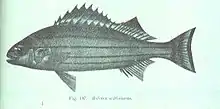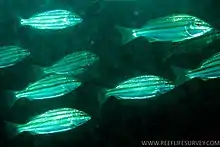Eastern striped grunter
The Eastern striped grunter (Helotes sexlineatus) is a species of marine ray-finned fish, a grunter from the family Terapontidae. It is found in the Indo-Pacific region where it is found in coastal waters and is an omnivore.
| Eastern striped grunter | |
|---|---|
 | |
| Scientific classification | |
| Domain: | Eukaryota |
| Kingdom: | Animalia |
| Phylum: | Chordata |
| Class: | Actinopterygii |
| Order: | Perciformes |
| Family: | Terapontidae |
| Genus: | Helotes Cuvier, 1829 |
| Species: | H. sexlineatus |
| Binomial name | |
| Helotes sexlineatus | |
| Synonyms[2] | |
| |
Description
The Eastern striped grunter is a small species of grunter with an oblong body which has slight lateral compression. It has jaws of equal length, a small oblique mouth the end of which extends to a level hallway between the nostril and the front edge of the eye. It has tricuspid teeth with the cusps all being the same size and which are arranged in bands on each jaw with the outermost row of teeth having the largest teeth. The dorsal fin has 11or 12 spinesand 9 to 11 soft rays, the spiny part of the fin is arched with the fifth or sixth spines being longer than the others and the second last spine is shorter than last spine. The anal fin has 3 spines and 9 to 11 soft rays.The lateral line contains 76 to 87 pored scales. The upper part of the body is greyish or bluish in colour while the lower part of the body is silvery or whitish. There are 5 to 8 narrow, dark brown or black horizontal stripes along the body. The midlateral stripe reaches the base of the caudal fin. The spiny portion of the dorsal fin has a black margin on the membranes between the spines membranes. There is a dark blotch on the body behind the nape and shows variation in the intensity of its pigment. The caudal fin has a dark border and several bands made up of faint spots at its base, but lacks obvious transverse black striping.[3] the maximum total length is 15 centimetres (5.9 in).[2]
Distribution
The Eastern striped grunter is found from Singapore east to Australia and north to China and Okinawa.[3] It has been reported from India but this need to be confirmed.[1]
Habitat and biology
The eastern striped grunter is found at depths of 1 to 30 metres (3.3 to 98.4 ft) and are found in schools in sheltered seagrass beds, sandy areas and in coastal reefs. It is most numerous in weedy areas close to the mouth of estuaries.[1] The juveniles inhabit seagrass beds, moving into them after ending their larval stage.[4] It is an omnivorous species[2] but the major part of its diet comprises small fishes and invertebrates.[3] The eggs are guarded and fanned by the male.[2]
Taxonomy
The Eastern striped grunter was first formally described as Terapon sexlineatus in 1825 by the French naturalists Jean René Constant Quoy and Joseph Paul Gaimard with the type locality given as Shark Bay, Western Australia.[5] Georges Cuvier created the monotypic genus Helotes for this species in 1829[6] and most authorities retain this species as the only species in this genus.[7]
Fisheries
The Eastern striped grunter is of minor commercial importance to Fisheries,[1] and is often taken as bycatch.[4] It is caught using handlines , seine nets and other inshore fishing gear. The catch is marketed fresh.[3] It is also targeted by recreation fishermen in New South Wales.[4]

References
- Herdson, D. (2017) [errata version of 2010 assessment]. "Pelates sexlineatus". IUCN Red List of Threatened Species. 2010: e.T155026A115262017. doi:10.2305/IUCN.UK.2010-4.RLTS.T155026A4704454.en. Retrieved 4 May 2020.
- Froese, Rainer; Pauly, Daniel (eds.) (2019). "Helotes sexlineatus" in FishBase. December 2019 version.
- R.P. Vari. "Terapontidae" (PDF). FAO. Retrieved 2 May 2020.
- Bray, D.J. (2019). "Helotes sexlineatus". Fishes of Australia. Museums Victoria. Retrieved 4 May 2020.
- Eschmeyer, William N.; Fricke, Ron & van der Laan, Richard (eds.). "Terapon sexlineatus". Catalog of Fishes. California Academy of Sciences. Retrieved 4 May 2020.
- Eschmeyer, William N.; Fricke, Ron & van der Laan, Richard (eds.). "Heloyes". Catalog of Fishes. California Academy of Sciences. Retrieved 4 May 2020.
- Froese, Rainer and Pauly, Daniel, eds. (2019). Species of Helotes' in FishBase. December 2019 version.
